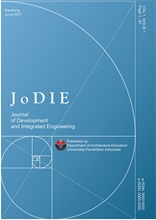ANALYSIS OF THE LEBAK BULUS MRT TOD AREA, DKI JAKARTA, BASED ON CHALLENGES AND EXPECTATIONS OF CONVENIENCE ORIENTATION
Abstract
Transit-oriented development (TOD) is often defined in terms of mixed development that is close to and/or oriented toward mass transit facilities. General characteristics of TOD include urban cohesiveness, pedestrian and bicycle friendly, public spaces near stations, and stations designed to be community centers. The Lebak Bulus area is strategic and is quite popular as a terminal area that has the potential to support transportation between regions and between cities, as well as being a gathering point for community groups from various levels and backgrounds. In principle, the change in function of the terminal area to the TOD area is expected to have a positive impact on the behavior of public transportation users, although there are still some things that need to be improved. As a recommendation from this study, it is necessary to improve accessibility, such as by improving road and sidewalk conditions, as well as improving feeder transportation and parking services for private vehicle users. In addition, it is necessary to rearrange the environment around the station by optimizing the potential of buildings around the station, improving the quality of parks, pedestrians, and crossing areas, and considering the use of renewable energy. Increased security and safety (use of CCTV) also need attention. The implication of this research is that the TOD area must be built by taking into account the aspects of sustainability, the role of the community and stakeholders (government, developers, and the community) in the development of the TOD area is very important. By implementing the recommendations and implications of this research, it is hoped that the Lebak Bulus MRT TOD area of DKI Jakarta can develop optimally and provide maximum benefits for the community.
Keywords: Transit Oriented Development, TOD, Lebak Bulus MRT, convenience
Full Text:
PDFReferences
Akbardin, J., & Permana, A. Y. (2020). The Characteristics Study Of Parking User Behavior Toward Location Accessibility Of Non-Commercial Activities Center. International Journal of Advanced Science and Technology, 29(7), 3293–3300.
Anissa, I. N., Saladin, A., & Rahmah, N. (2020). Konsep Integrasi Stasiun Lrt Bekasi Timur Dengan Kawasan Mixed-Use Lrt City Bekasi Timur. Jurnal Arsitektur ZONASI, 3(3), 291–298. https://doi.org/10.17509/jaz.v3i3.27050
Appleyard, D., Lynch, K., & Myer, J. R. (1964). The view from the road. MIT Press.
Calthorpe, P. (1993). The next American metropolis: Ecology, community, and the American dream. Princeton Architectural Press.
Cervero, R. (1998). The transit metropolis: A global inquiry. Island Press.
Cervero, R. (2013). Transit-oriented development's ridership bonus: A product of self-selection and public policies. Environment and Planning A, 45(4), 800-814. https://doi.org/10.1068/a45196
Cervero, R., & Kockelman, K. (1997). Travel demand and the 3Ds: Density, diversity, and design. Transportation Research Part D: Transport and Environment, 2(3), 199-219. https://doi.org/10.1016/S1361-9209(97)00009-6
Dittmar, H., & Ohland, G. (2004). The new transit town: Best practices in transit-oriented development. Island Press.
Ewing, R., & Cervero, R. (2010). Travel and the built environment: A meta-analysis. Journal of the American Planning Association, 76(3), 265-294. https://doi.org/10.1080/01944361003766766
Gurran, N., & Phibbs, P. (2017). When is a 'town centre' not a town centre? The case of Parramatta, Australia. Journal of Urban Design, 22(4), 492-510. https://doi.org/10.1080/13574809.2017.1308557
Hall, P. (1998). Cities in Civilization: Culture, innovation, and urban order. Pantheon Books.
Handy, S. (2005). Smart growth and the transportation–land use connection: What does the research tell us? International Regional Science Review, 28(2), 146-167. https://doi.org/10.1177/0160017604273853
Hermawan, Hindaryanto, A., & Taoda, A. (2021). KARAKTERISTIK TERMAL RUMAH BATU EKSPOS DI TROPIS PEGUNUNGAN ( Studi Kasus di Desa Kwadungan , Wonosobo ). Jurnal Arsitektur Zonasi, 4, 153–166.
Hess, D. B., & Moudon, A. V. (2010). Built environment and health. In R. G. Golledge (Ed.), Handbook of geographic information science (pp. 677-696). Springer.
Jesson, JK, Matheson, L., & Lacey, FM (2011). Doing Your Literature Review: Traditional and Systematic Review. Los Angels: SAGE Publications Ltd
Knaap, G. J., & Hopkins, L. D. (2011). Smart growth and its role in contemporary planning practice. In The Routledge Handbook of Planning Theory (pp. 324-338). Routledge.
Milenia, D., & Purwantiasning, A. W. (2021). Kajian Konsep Arsitektur Kontekstual Bentuk pada Bangunan Perkantoran di Kawasan SCBD Sudirman Jakarta Selatan. 4(3), 396–408.
Newman, P., & Kenworthy, J. (1999). Sustainability and cities: Overcoming automobile dependence. Island Press.
Permana, A. Y., & Wijaya, K. (2017). Spatial change transformation of educational areas in Bandung. IOP Conference Series: Earth and Environmental Science, 99, 012029. https://doi.org/10.1088/1755-1315/99/1/012029
Permana, C. S., Permana, A. Y., & Dewi, N. I. K. (2020). Penerapan Konsep Green Architecture dalam Perancangan Hotel Resort di Kabupaten Tasikmalaya. UNDAGI: Jurnal Ilmiah Arsitektur Universitas Warmadewa, 8(2), 82–94.
Rizqi, N. M., & Ashadi. (2020). KAJIAN KONSEP IKONIK PADA BANGUNAN FASILITAS OLAHRAGA BENTANG LEBAR : Kasus Stadion Utama Gelora Bung Karno. Jurnal Arsitektur Zonasi, 3(2), 233–241.
Talen, E. (1999). Sense of community and neighborhood form: An assessment of the social doctrine of new urbanism. Urban Studies, 36(8), 1361-1379. https://doi.org/10.1080/0042098993049
Yang, C., & Ferreira, J. (2019). Transit-oriented development: A review of recent literature. Transport Reviews, 39(6), 810-833. https://doi.org/10.1080/01441647.2019.1571292
DOI: https://doi.org/10.17509/jodie.v1i2.55669
Refbacks
- There are currently no refbacks.
Copyright (c) 2023 Zul Setiawan

This work is licensed under a Creative Commons Attribution-NonCommercial-ShareAlike 4.0 International License.

This work is licensed under a Creative Commons Attribution-ShareAlike 4.0 International License.








